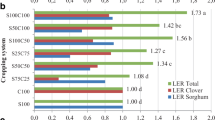Abstract
This research was conducted in order to determine the effects of different intercropping patterns of sorghum with soybean on agronomic characters and forage yield in Bilecik and Kahramanmaraş Turkey, in 2015 growing season. Experiments were planned as containing three intercropping patterns in alternate rows and pure stands for individual crops with three replications at two locations. As a result of the study, sorghum was determined as clearly dominant crop in producing high yield. Therefore, decreasing sorghum plant seeding rate in mixture caused a decrease in total yield. But soybean presence in forage induced a significant increase in protein content of forage. As a result, the land equivalent ratio with intercrops was higher as compared to pure plants, especially in intercropping systems in which sorghum plant density was not reduced more than 66% of sole sorghum.
Similar content being viewed by others
References
Ahmad AH, Ahmad R, Ahmad N, Tanveer A (2007) Performance of forage sorghum intercropped with forage legumes under different planting patterns. Pak J Bot 39:431–439
Akhtar MF, Azraf-ul-Haq Ahmad AH, IbniZamir MS, Khalid F, Mohsin AU, Afzal M (2013) Agro-Qualitative studies on forage sorghum (Sorghum bicolor L.) sown alone and in mixture with forage legumes. Pak J Sci 65(2):179–185
Akunda EMW (2001) Crop yields of sorghum and soybeans in an intercrop. J Food Technol Afr 6(1):2–4
Andersen MK, Hauggaard-Nielsen H, Ambus P, Jensen ES (2005) Biomass production, symbiotic nitrogen fixation and inorganic N use in dual and tri-component annual intercrops. Plant Soil J 266(1–2):273–287. https://doi.org/10.1007/s11104-005-0997-1
AOAC (1990) Official methods of analysis, 15th edn. Association of Official Analytical Chemists, Washington
Banik P, Bagchi DK (1993) Effect of legumes as a sole and intercrop on residual soil fertility and succeeding crop in upland situation. Indian J Agric Sci 37:69–75
Chang JF, Shibles RM (1985) An analysis of competition between intercropped cowpea and maize. Field Crops Res 12(2):133–143
Elemo KAV, Kumar Olukosi JO, Ogunbile AO (1990) Review of Research work on mixed cropping in the Nigerian savanna. Samaru Miscellaneous Paper 127, p 125
Erdoğdu I, Altinok S, Genc A (2013) The effects of sowing rate on some plant characteristics and feed efficiency of different seeded corn and soybean plant. Biol Sci Res J 6 (1):06–10. ISSN: 1308-3961, E-ISSN: 1308-0261, www.nobel.gen.tr
Erol A, Kaplan M, Kızılşimşek M (2009) Oats (Avena sativa)—common vetch (Vicia sativa) mixtures grown on a low-input basis for a sustainable agriculture. Trop Grassl J 43:2009
Henriet G, Van EK, Blade ASF, Singh BB (1997) Quantitative assessment of traditional cropping systems in the Sudan Savannah of northern Nigeria. Rapid survey of prevalent cropping systems. Samaru J Agric Res 14:37–45
Ibrahim HA, Singh L, Babaji GA (2014) Evaluating yield performance of cowpea varieties under sole and intercropping with sorghum at Bauchi, Nigeria. Ethiop J Environ Stud Manag 7:709–719
Kavut YT, Geren H, Soya H, Avcıoğlu R, Kır B (2014) Karışım Oranı ve Hasat Zamanlarının Bazı Yıllık Baklagil Yembitkileri ile İtalyan Çimi Karışımlarının Kışlık Ara Ürün Performansına Etkileri. Ege Üniv Ziraat Fak Dergisi 51(3):279–288
Lamessa K, Sharma JJ, Tessema T (2016) Influence of Cowpea and Soybean Intercropping Pattern in Sorghum on Striga (Striga hermonthica) Infestation and System Productivity at Mechara, Eastern Ethiopia. J Biol Agric Healthc 6(17):72–81
Lithourgidis AS, Vasilakoglou IB, Dhima KV, Dordas CA, Yiakoulaki MD (2006) Forage yield and quality of common vetch mixtures with oat and triticale in two seedling ratios. Field Crops Res 99:106–113
Lopez-Bellido Garrido RJ, Lopez-Bellido L (2001) Effects of crop rotation and nitrogen fertilization on soil nitrate and wheat yield under rained Mediterranean conditions. Agron J 21:509–516
Mead R, Willey RW (1980) The concept of a ‘land equivalent ratio and advantages in yields from intercropping. Exp Agric 16:217–228
Raseduzzaman Md, Jensen ES (2017) Does intercropping enhances yield stability in arable crop production? Ameta-analysis. Eur J Agron 91:25–33
Redfearn DD, Buxton DR, Devine TE (1999) Sorghum intercropping effects on yield, morphology and quality of forage Soybean. Crop Sci J 39:1380–1384
Umuna NN, Osuji PO, Khalili H, Nsahlai IV, Crosse S (1995) Comparative feeding value of forages from two cereal-legume based cropping systems for beef production of crossbred (Bostaurus X Bosindicus) steers and subsequent performance of underfed and realimented steers. Anim Sci 61:35–42
Van Ek GA, Henriet SF, Singh BB (1997) Quantitative assessment of traditional cropping systems in the Sudan savanna of northern Nigeria. II. Management and productivity of the major cropping systems. Samaru J Agric Res 14:47–60
Van Soest PJ, Robertson JD, Lewis BA (1991) Methods for dietary fibre, neutral detergent fibre and non-starch polysaccharides in relation to animal Nutrition. J Dairy Sci 74:3583–3597
Acknowledgements
The authors wish to thank all who assisted in this work.
Author information
Authors and Affiliations
Corresponding author
Additional information
Editorial responsibility: Dr. iskender Akkurt.
Rights and permissions
About this article
Cite this article
Kızıl Aydemir, S., Kızılşimşek, M. Assessing yield and feed quality of intercropped sorghum and soybean in different planting patterns and in different ecologies. Int. J. Environ. Sci. Technol. 16, 5141–5146 (2019). https://doi.org/10.1007/s13762-018-1948-8
Received:
Revised:
Accepted:
Published:
Issue Date:
DOI: https://doi.org/10.1007/s13762-018-1948-8




